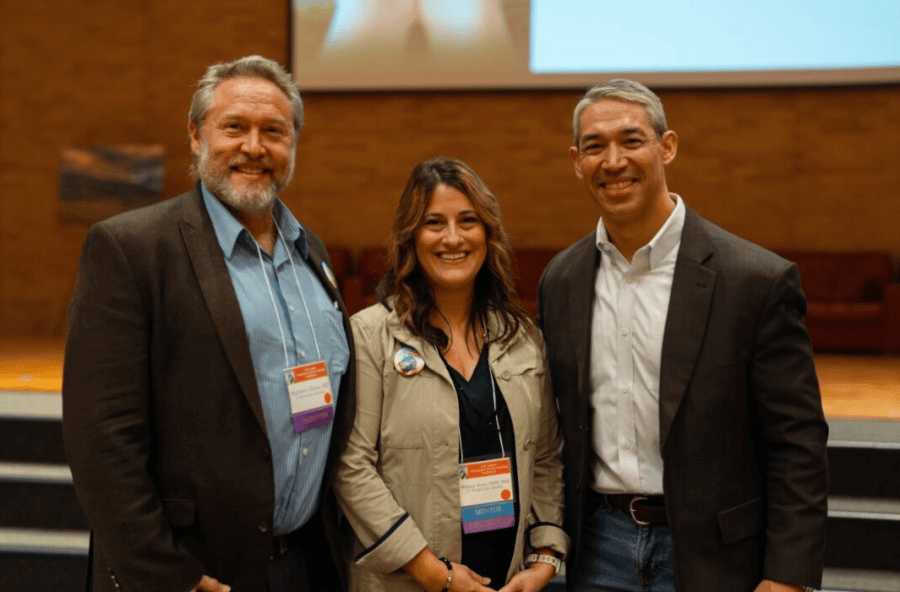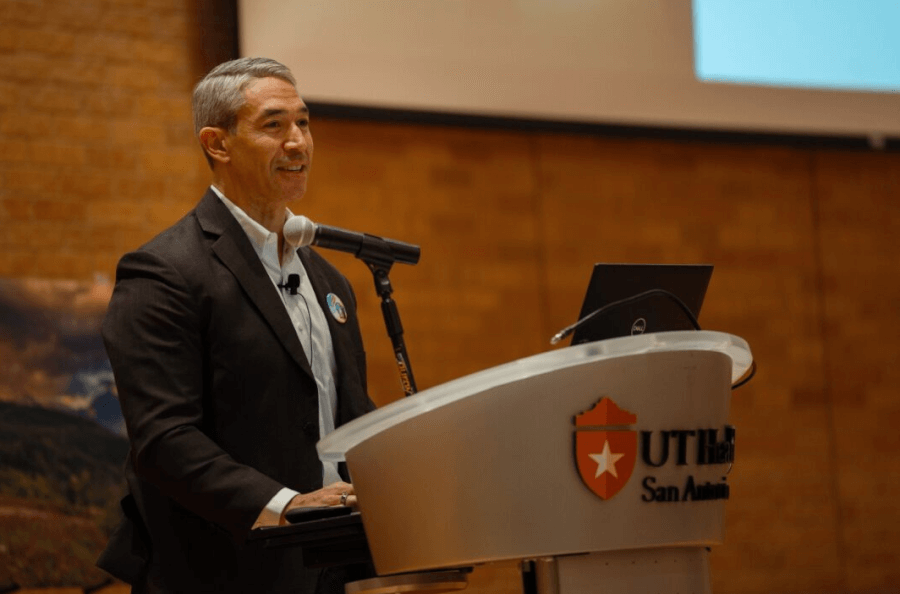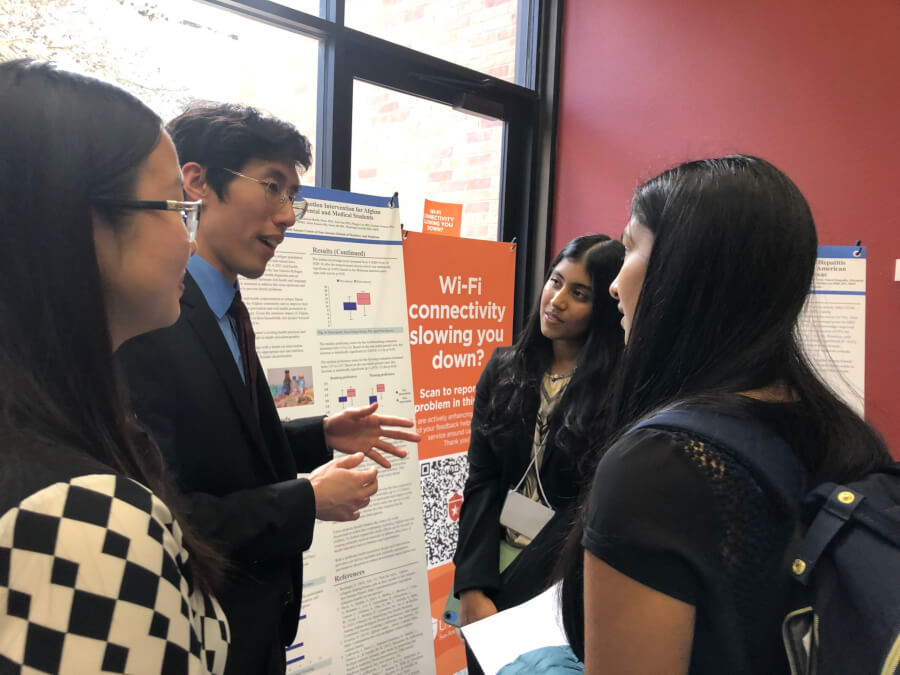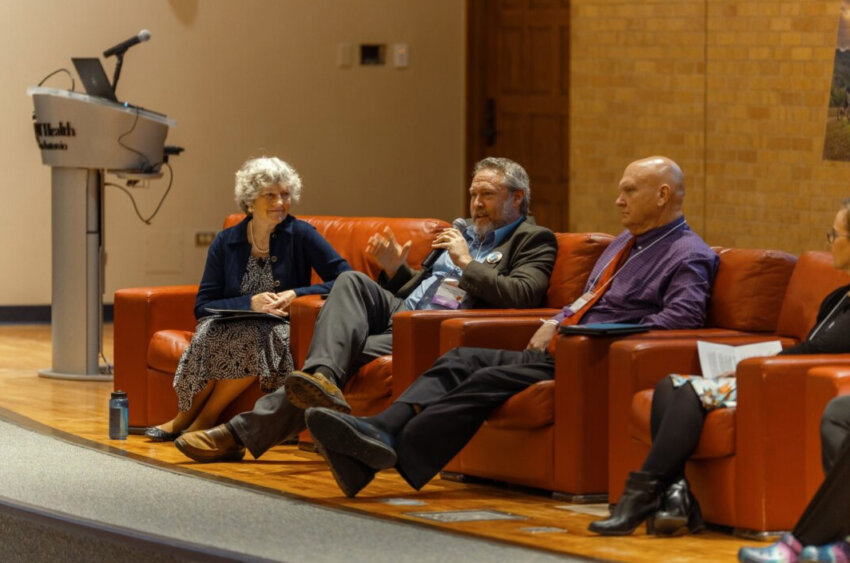The Charles E. Cheever Jr. Center for Medical Humanities and Ethics hosted its 17th annual Community Service Learning Conference on Feb. 3 under the theme “One Planet. One Health. We are all connected.”

“Our planning committee chooses a theme each year that is based on the pulse of what is important in the community,” said Melanie Stone, DrPH, MEd. “In other words, what is an issue that our community partners are seeing with their clients and what needs are we addressing in health care?”
Stone is the Cheever Center’s director of Community Service Learning and an assistant professor of Family and Community Medicine at The University of Texas Health Science Center at San Antonio’s Joe R. and Teresa Lozano Long School of Medicine.
“The focus on planetary health has been brought up for several years, and pressing challenges like natural disasters, climate change and mental health prioritized it for this year,” Stone said.
Teddie M. Potter, PhD, RN, FAAN, FNAP, clinical professor and director of Planetary Health at the
University of Minnesota School of Nursing was invited as the conference’s keynote speaker to share information about the connection between planetary health and human health.
A sense of urgency
Potter, a native Minnesotan, shared her personal observations of environmental shifts over the years, from thinning ice on once-frozen rivers to the altered migration patterns of robins. Amidst her reflections, Potter pointed out the shifts Texans will continue to experience, according to the Texas 2036 Report.

“There is more intense severe weather, a significant increase in urban flooding, hurricane intensity, more 100-degree days and increased drought,” Potter said. “Think about the homes, businesses, major thoroughfares affected and the families who are relocating because of it. Think about the hospitals and clinics in those spaces. How are we preparing?”
The United Nations considers these events as signs of the triple planetary crisis, which is comprised of three main interlinked issues that humanity currently faces: climate change, pollution and biodiversity loss. “These changes in the environment severely affect human health and jeopardize decades of public health gains,” Potter said.
According to the Planetary Health Alliance, environmental changes affect instances of cardiovascular and respiratory diseases, infectious diseases, antimicrobial resistance, heat stroke, malnutrition, mental health and much more.
“This should produce a sense of urgency in health professionals,” Potter said. “It doesn’t matter what specialty you are going to be working in, you will be helping citizens to stay alive through what’s coming.”
The Great Transition
It’s through holistic and interdisciplinary approaches such as Planetary Health, One Health and EcoHealth that Potter finds hope. Each method seeks to safeguard the health of the human–animal–environment system.
“We’ve all had a hand in this, but the good news is we can all be a part of the solution. This is the hard part,” Potter said.

The health care sector impacts climate change. In the United States, health care constitutes nearly 20% of the gross domestic product, making it a substantial consumer of resources and emitter of waste and greenhouse gases, as noted by the National Academy of Medicine.
The U.S. ranks among the leading contributors to carbon emissions globally, responsible for a quarter of emissions from the health care sector worldwide. This proportion is the highest compared to all other global health sectors. These emissions originate from various sources within health care, including the operation, heating, and cooling of facilities, as well as the supply chain associated with healthcare services and goods.
“Health professionals need to play an active role in shaping a more sustainable future,” Potter said. “We need to be mindful and make decisions based on how it will impact those seven generations down the line.”
San Antonio sustainability
The City of San Antonio has firsthand experience making tough decisions toward sustainability, according to special guest speaker and San Antonio Mayor Ron Nirenberg.
“San Antonio is one of the fastest growing municipalities in the nation,” Nirenberg said. Between 2021 and 2022, San Antonio added 18,000 residents …sustainability is something we must consider.”
To supply the city’s growing residency with adequate energy, water and transit options, Nirenberg said that conservation remains key, though there are initiatives in affect that have already proven successful.
According to a report from the Environment America Research and Policy Center, San Antonio is Texas’ top producer of solar energy and the fifth-largest in the nation.
The mayor said San Antonio will phase out the use of coal for energy generation by 2028, more than 35 years sooner than originally planned.

“The amount of energy that we need to produce in order to meet the demand in the years to come is simply stunning. So, where that generation comes from is extremely critical for our future. The plan that we have now will add more than 4900 megawatts of generation capacity, including wind and solar capacity as well as battery storage,” Nirenberg said.
In addition to cleaner energy, Nirenberg added that San Antonio’s public energy utility has weatherized 30,000 income-qualifying homes over the last decade through its Casa Verde program and created over $553 million in bill savings through its Sustainable Tomorrow Energy Plan, an energy savings and rebate program.
The city is also working with San Antonio Water System to meet a growing water demand through the Vista Ridge Pipeline project, the “largest non-Edwards Aquifer” water supply project in the utility’s history, according to its website.
San Antonio is seeking to mitigate the urban heat island, launched an electronic vehicle recharging incentive program, requires new homes to be solar ready and is gearing up for a new rapid mass-transit line that promises faster, more efficient and low-cost travel options.
“In order for us to create a sustainable planet, a sustainable San Antonio, we have to recognize that everyone needs to have access to these opportunities. …Sometimes mitigation efforts are most impactful to people who can least afford them, which makes us change the way we think and makes us work together in more systems-aligned measures. We have done that quite well in San Antonio,” he said.
Service in action
Similarly working together, students involved in community service learning (CSL) have been identifying the pressing health needs of their surrounding community members and developing innovative projects to address them, said Stone.
An average of 1,400 students engage in CSL projects annually, clocking 20,000 service hours that benefit about 10,000 community members.
“CSL students are mentored by community-minded UT Health San Antonio faculty physicians and other health professionals. Over 60 community organizations partner with us annually and receive free, high-quality health services and education for their clients,” she said.
The annual event had 70 student project posters displayed in categories that include advocacy and policy, capacity building, clinical service, education and outreach.
One group of medical and dental students, mentored by Moshtagh Farokhi, DDS, MPH, partnered on a project which sought to empower female Afghan refugees by improving their well-being through disease prevention and oral health promotion.

While volunteering at the San Antonio Refugee Health Clinic, the students provided oral health education and created culturally appropriate oral hygiene and nutrition health instructional videos in the Pashto language.
“This project was impactful to me personally and professionally because we tend to assume people already know this information, but that’s not the case,” said Hamsini Nathan, a second-year dental student.
“Oral health is tied to systemic health,” said James Yan, a second-year medical student. “This experience taught us so much about community and culture — this is the real world.”
Upon gathering the results of their group’s project, Nathan and Yan presented that the oral hygiene and healthy diet habits of program participants significantly increased as did their toothbrushing proficiency.
“For the past 17 years, the CSL conference, which is the only one of its kind amongst health science centers in Texas, has highlighted the vital role that community service learning plays in our health care system,” Stone said. “It is an opportunity to discuss cutting-edge ideas and practical solutions and showcase the people-centered work of our students and faculty. What makes this conference different is that it brings together public health, social service work and health care professionals to share their expertise and experience with the goal of working in unison to deliver compassionate, innovative and quality health care to our community.”
The learn more about this year’s conference and community service learning, visit the Charles E. Cheever, Jr. Center for Medical Humanities and Ethics website.


